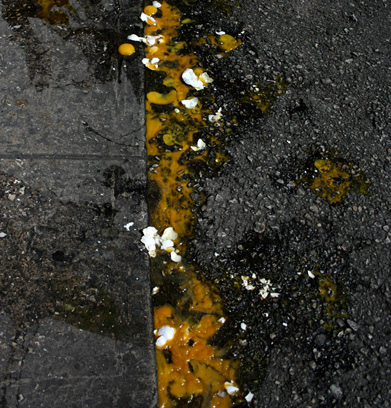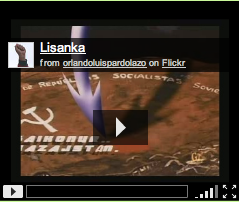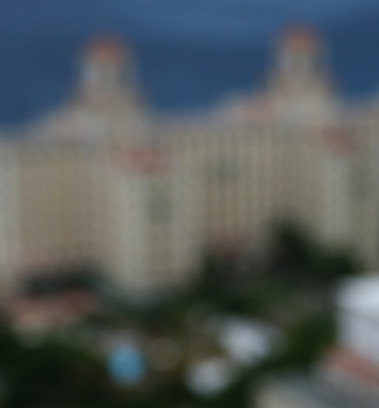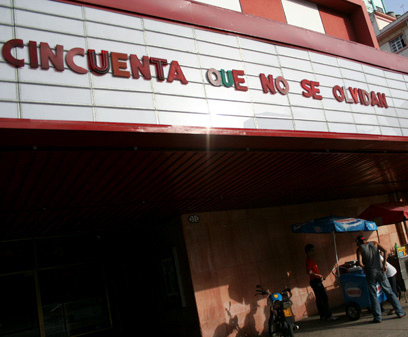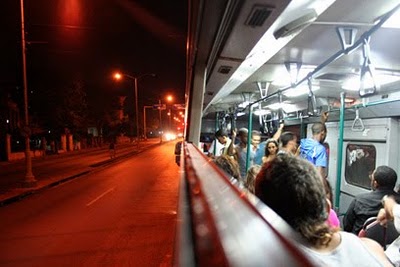Category: Orlando Luis Pardo Lazo
Lisanka
RIDLEY OR REDFORD READ ME, PLEASE…!!! / Orlando Luis Pardo Lazo
YOU TOO, YOUTUBE…?

Cuba is excluded from YouTube’s digital world map. What happens behind the closed doors of this paleopolitical Internet Island is of no concern to YouTube and, in consequence, nor to the audiovisual eyes of the world. The clever papal slogan from the past century and millennium resonates now like a coarse cathedral comedy script: “Let Cuba open itself to the world and let the world open itself to Cuba…” Pope John Paul II declared in Havana.
So there seems to be nothing subliminal in the censorship of the current Life in a Day contest, organized by YouTube to document one day of life: specifically, this July 24. The countless scenes shot last Saturday of the planet Earth, in any language, with a high definition professional camera or a cellphone, can be sent by their authors until today, July 31, to the YouTube channel created especially for the marathon.
Although there is no financial remuneration involved, after their work is selected the finalists will be edited into a feature-length documentary directed by Kevin McDonald and produced by Ridley Scott, who plan to premiere it at the Sundance Film Festival in January 2011.
The theme is open, but the suggestions of the YouTube chef are quite chic: What do you love? What do you fear? What makes you laugh? What’s in your pocket? Is there a story behind any of the objects? There is room for the “ordinary” (a sunrise, a neighborhood soccer game) as well as the “extraordinary” (a baby’s first steps, a wedding, the reaction to the loss of a loved one).
So, a young woman in Havana thought there would also be room for Cuba. Elena Victoria Molina, 21, a graduate of Onelio Jorge Cardoso’s Narrative Techniques Workshop, a student of Audiovisual Communication at the Superior Art Institute, co-editor of the independent literary magazine 33 and 1/3, and participant in many freelance projects, took YouTube’s propaganda at face value.
Molina has watched YouTube for three years and, in her own words, she thought, “If I did well I could be among those selected, and it would be a magnificent opportunity to talk about daily life in Cuba from a personal point of view.” So she prepared to compete, “To express my opinions about my country, my society, my life, in a framework that would ensure that more people would see our reality and what life looks like from a Cuban perspective.”
Her raw material (they specified unedited video), recorded on July 24, 2010, in an apartment in the vicinity of the Plaza of the Revolution, showed her a bit oblivious, with her boyfriend, “lying around in bed, reading Virginia Woolf, writing in my diary, while on TV the country was enmeshed in the preparations for the July 26 celebration, and some neighbors had hung July 26 flags from their houses. I thought it showed something very common in Cuba: the contrast between the private and the public worlds, that we have a different sensibility, because we live a dual image, what we are collectively, and what we are individually. And it’s difficult to maintain the intimate space of the home when the outside is constantly invading, particularly around national anniversaries of the Revolution.”
But it turned out YouTube’s invitation included a clause that froze her enthusiastic rush to this kind of amateur Oscar lottery: Who can participate in Life in A Day? Anyone over 18 can send footage, except citizens or residents of Cuba, North Korea, Iran, Myanmar (Burma), Syria and Sudan, and other people and entities limited by the United States’ program of export controls and sanctions.
Commenting to this reporter, the young Molina (who also made comments in protest on several Cuban blogs, on her Facebook account, and even on the censored contest’s YouTube channel) remarked, “To read that was very disappointing, that a law closes one of the few spaces for expression. It’s an unjust ban that severely limits the very purpose of the project, if the idea is to show a truly ‘normal day’ from the most diverse experiences of the globe.
“What we call a typical day is very different from other parts of the world, given that our life has been shaped in a peculiar way under the system we live in. It’s absurd and frustrating that U.S. laws, supposedly established to support freedom, in practice restrict our freedom of expression and block Cuban citizens from communicating with the world. The American embargo affects individuals who have nothing to do with the government. I feel I have been discriminated against.”
Of the millions of visualizations that human beings ritually watch on YouTube, none will clash, in this “historic cinematic experiment” with the view of 21-year-old Elena Victoria Molina.
The “information capsule for the future,” like a postnational Trojan Horse, will lack any Cubans in its gigabyte guts. We Cubans will star in another alien saga of those who still haven’t come out of the communist closet, in this case because the laws of a democracy don’t want us to. In dramatic terms, we are not even the Other.
“It must be personal, that’s what we’re looking for,” commented the director Ridley Scott, in a videoclip about this project to take the aesthetic of crowd-sourcing to the limit. This throws enough literary light on the nature of we non-persons who live in Cuba, North Korea, Iran, Myanmar (Burma), Syria and Sudan. But it doesn’t matter, some proxy will absolve us. For now, the epitaph of that already remote film, Blade Runner, is being rewritten, even before the first showing of this unfortunately despotic documentary: “Like tears in YouTube…”
The thousand and one YouTube Community Standards, so concerned about protecting us from the pornography and realistic violence that daily gnaw at our civilization, have given Cuba a cultural lesson with this abusive Shift-Delete: “Let Cuba close itself to the world and let the world delete Cuba..”
YOU TOO, YOUTUBE…?, originally uploaded by orlandoluispardolazo.
ROOTS OF THE WASHINGTONAVANA POST
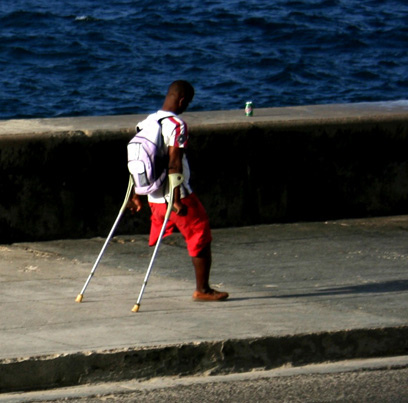
RAÍCES DEL WASHINGTONABANA POST, originally uploaded by orlandoluispardolazo.
www.theroot.com/multimedia/photos-cuba
JORGE LAGEZAMA LIMA / Orlando Luis Pardo Lazo
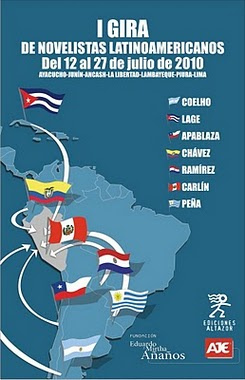 JORGE LAGEZAMA LIMA, originally uploaded by orlandoluispardolazo.
JORGE LAGEZAMA LIMA, originally uploaded by orlandoluispardolazo.
la-fortaleza-de-la-soledad.blogspot.com/2010/06/ediciones…
Months back, Willy del Pozo and Harold Alva, editor and deputy editor respectively of Altazor Editions, told me about an important project they were thinking of going forward with. Weeks passed and the objective showed signs of being coming off, and then they put it on hold to start the first tour of Latin American novelists, that will take them through different cities in the interior of the country, finishing in Lima the gray.
Authors who make up the delegation are: Ernesto Carlin (Peru), Claudia Apablaza (Chile), Miguel Antonio Chávez (Ecuador), Oliverio Coelho (Argentina), Jorge Enrique Lage (Cuba), Pedro Peña (Uruguay), Juan Ramirez Biedermann ( Paraguay).
For those who do not know, the publisher headed by Willy del Pozo led off its revival last year with nice editions that have enjoyed the sign of criticism and genuine appreciation by readers. Among them are JOURNEY THAT NEVER ENDS by Carlos Calderón Fajardo; MIGRATION by Victor Coral; as well as on the long-winded novel VALLEJO AND CELL NON PLUS ULTRA of Jorge Najar.
This first tour of Latin America represents for Altazor his definitive consecration in the panorama of publishers in Peru. All authors included in this catalog have a wide impact internationally. I know.
Last year Altazor Editions did the first tour of Peruvian writers in the north of the country. The experience was rewarding, it could not be otherwise if in the Altazor-mobile were Carlos Calderón Fajardo and Socrates Zuzunaga. Then we promise to repeat the adventure but thought to involve all the writers in our America. What started as a topic of conversation gained in seriousness and now we are pleased to announce the launch of the FIRST TOUR OF LATIN AMERICAN NOVELISTS, which opens in Ayacucho on July 12 and will close in Lima on July 26. The itinerary includes the Ayacucho, Junín, Ancash, La Libertad, Lambayeque, Piura and Lima.
This event is made possible through our strategic alliance of our publisher with the Eduardo and Mirtha Añaños Foundation. Which confirms that you can still work on projects of this nature with other private companies who have understood the importance of culture. This tour begins in the manner of a liberating expedition and coincides with the bicentenary of Latin American political independence. It will leave from Ayacucho to other cities such as Huanta, Tarma, Huancayoin our central Andes and continue north to Chiclayo and then Piura, a city where Jorge Tume, with Infolectura, has organized the First International Book Fair.
We know that this is an event whose significance is due to the quality of the invited writers, authors under 40 who present powerful works which speaks of the excellent health of Latin American literature. A contribution that without a doubt will do its part to heal the fractures of an area overwhelmed by the constant political, social and economic crises. This first tour will include the following writers: Oliverio Coelho (Argentina) with his novel BORNEO; Jorge Enrique Lage (Cuba) with CARBON 14: A NOVEL OF WORSHIP; Claudia Apablaza (Chile) with EME / A; Miguel Antonio Chávez (Ecuador) with The Heimlich maneuver; Pedro Peña (Uruguay) THE NIGHT THAT IS NOT REPEATED; Ernesto Carlin (Peru) TAKASHI: STOLEN STORIES; and Juan Ramirez Biedermann (Paraguay) THE FUND OF NOONE. They are ones responsible for this new itinerary, they are our choices, with them and for them we leave, two hundred years later, on another expedition of liberation.
ALL ABOUT DAD / Orlando Luis Pardo Lazo

ALL ABOUT MY FATHER
Orlando Luis Pardo Lazo
Reading miracles in Mirta Suquet’s blog.
My father didn’t beg for alms, but depended on a brother and another son in the USA. My father had to go out into the street to sell a little packet of anything, even though he gave English classes at home like a horse. My father lived at home until he was 81, when he was already practically just the father of my mother (17 years separated them). My father, the grandfather who never had a “grand.”
Every day I return from the street with my father in the Canon camera and my head burned by the sun and so much loneliness. I took almost no photos of my father when he was alive. And now I am paying the price of this adolescent neglect (I was the son of his old age).
So I find him on the Cuban sidewalks and porches. Gasping, badly shaved. With humble clothes that always smell of Populares cigarettes at 1.60 pesos (a strange aroma: all smokers stink, except him). A guy so affectionate, when I would dare to say half a word to him. So clumsy with practical things, so deluded by useless writings. Of an immortal look when my psycho-rigidity would allow me to say, from time to time (from voice in time): papá…
He died in August, as everyone dies in this noxious Tropical month. Of cancer, as befits a country with no cutting edge diagnostics. Nor therapy. All of a sudden, fortunately. Without pain. My father died of a merciful metastasis, amateur, between a rare vomiting fit of so-called “coffee grounds” and the ballads on Radio Martí, on a Selena radio before the Special Period.
Since then, I’ve seen him many times and always photographed him. I never talk to him in the street. But at home, I do. Always. ¡Papá, coño, if it’s all the same…! Papá, ¿is it true that you are never going to die again…?
My mother ignores all this traffic in emotions. She waters his flowers every day. Cuts off their heads with the punctuality of an executioner. My mother is a terror with the shears in our garden. And she prays for my father, with the timidity of someone who is getting old and still doesn’t know if she has the right to pray (solicitous servant in capitalism, mute worker in communism: my mother did know how to resist).
There s no consolation for not seeing my father, I suppose. But I invented one when the socialized sadness of Cuba wouldn’t stop. Then I search through my photos of street knights fallen in the uncivil trenches of Havana, feeling on the liquid screen and the chrome paper the marvelous myopic eyes of my papá. Even that WOW!, here he is again, like new, photographed as if he hadn’t died exactly ten years ago. The days will return.
And I’m glad, like a stupid student, that my father never asked for anything from strangers, neither in the crisis nor in the splendor; I applaud that his little businesses were a calamity without earnings because he didn’t need them. I delight and envy that in his 81 years he didn’t know a doctor except the naive and ignorant native who only discovered his cancer during the autopsy (just like since I was a kid I know that after the Zero Year or two thousand I would be left orphaned even of Cuba).
It was a Sunday. Thirteen. In August. With Little Pioneers on TV bringing the first flowers for comrade Fidel’s birthday that day ( ). That night, the Luyano funeral parlor (dim little premises with a republican plaque of the People’s Socialist Party) was more crowded than ever with old people left along to face the thin reality of the island’s 21st century (insipid night, improbable gardens). And right there I became to feel some deadly pride that my father wasn’t there.
Good evening again, false papá with emphysema in these pixels of today. You who are resuscitated in the next photo and soon breath your next flower (it seems like a terrible title from Manuel Cofiño, but the life of my father, somehow antipodean, was this stylistically). Until tomorrow then, forgetting of my papá (it’s a privilege to write, finally, without complexes these loose little phrases from primary school). I suspect that my grammar will not return. Rev in Peace!
OPEN LETTER TO PÍTER ORTEGA Y DESIDERIO NAVARRO

Based on what aesthetic criteria, according to the debaters, do the political experts perpetrate under our noses the native performance of the most cultured State in the world that is left to die by the concept of a hunger striker ignorant in art?
Thanking you in advance for your eloquent silence.
Orlando Luis Pardo Lazo,
Havanothing, Saturday, July 24, 2010 (less than one month from the nuclear Cubapocalypse).
LAGE: THE CULT NOVEL IN PERU
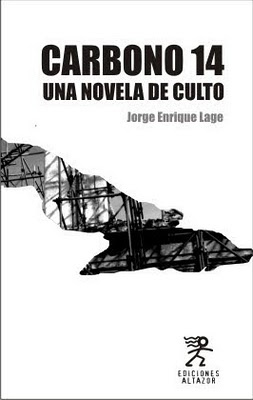
LAGE DE CULTO EN PERÚ, originally uploaded by orlandoluispardolazo.
“It was an endless city. Therefore, an unreal city. And the unreality exhausts.” So Jorge Enrque Lage offers us. A perfect metaphor for Cuba in the strokes of one of our most powerful storytellers. For this he constructs in Evelin a representation inwhich everything serves, in which everything is apt for developing a critical resistance where here personal traumas will keep a tight rein on the aesthetic tension that encodes the anguish of Latin America.Carbon 14: A cult novel, functions as a symbol of the decadence and the multimedia virtuosity that places Lage as a writer as one we must rad to understand the experimental possibility of a language that has lost, certainly, the idea of its border. Perhaps the most timely exercise to witness the vitality of the fictional landscape of America…
interview of the italian woman
RA RE RI RO RÚ
RA RE RI RO RÚ, originally uploaded by orlandoluispardolazo.
www.diariodecuba.net/opinion/58-opinion/2507-risa-y-contr…
CUBAN CODA
UNDERSTANDING THE CURTAIN AS A TRIUMPH
Orlando Luis Pardo Lazo
Do not talk anymore of Havana. Do not talk any more of Cuba. Do not talk anymore about the Revolution. Do not talk anymore.
As naive intellectuals, especially a Dictionary of grandiloquent words. Some Complete Works with patches of politically perfect paragraphs. An Encyclopedia stuffed with containers of lined paper, fucked.
It’s enough. There has already been enough submissive significance. We will be slightly satisfied with the idea that no more ideas will mediate between lyrical language and sparse reality. We welcome the silence with satisfaction. The lack of grammatical encouragement. We are less. Let us be more. The same period and also, to be consistent with myself, syntactically there should then be a period and full stop.
But Havana persists in plumbing our biographies of soldiers of the pen. But Cuba hardens us daily in a leaderless context. But the Revolution resists at the expense of the poor and fevered imagination of our senile forgetfulness, sociolopsistic to the point of suicide.
We cannot avoid this little formula H-C-R, even as a default. Because, in effect, it was right, as almost always, the most pedestrian political propaganda in the paleohistory of this nation. The experiment was a success.
So that, with so much repetition without giving credit, now we pay the price of supersaturation of such grandiose theater. From so much inhalation of its damp smoke,Havana has turned us into its gifted ventriloquists. From so much insult to or by Cuba, Cuba tracheotomized us. With so much rumination on its rhyming puns, the Revolution recruited us.
So again we type, timid and timorous, without being able to extirpate this tumor of three in our throat: histology more laughable than tired (second century (H-C-R). But, instead of the timeless clack-clack of the keys, what is heard is hypocritical whisper of rotting patriotic bronchi. The discursive madness of a terminal patient. The place of our nationalasthmatic obsessions. The mal-formed and metastatic protest of Havana in Cuba in Revolution.
These fossil symphonies speak today the name of our paraplegic intellectual. A ubiquitous and omniscient jargon. More than the sterile specter of an absolute State, these resonances simulate the hollow echo of God. Cynical and sentimental that they are.
Hangar Havana landing with a death rattle.
Cuba without clinical cure, a case already chronic.
Revolution in resurrection at the humiliating hour of say no more about Havana. Speak no more of Cuba. Say nothing more of the Revolution. Do not talk anymore. This full stop, even being an inconsistency with your, syntactically becomes then a full stop.
CALL FOR PAPERS…!
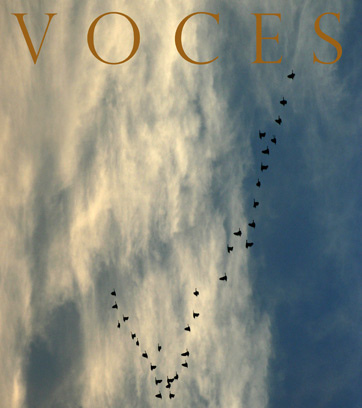 CALL FOR PAPERS…!, originally uploaded by orlandoluispardolazo.
CALL FOR PAPERS…!, originally uploaded by orlandoluispardolazo.
A new Cuban blog-literature magazine is about to publish its FIRST ISSUE from Havana. You are invited…!
Love In the Times of the Rocket
MOVIE HISTORY
Orlando Luis Pardo Lazo
A friend, who is me, told me that he can’t stand to hear Cuban actors act. That there is a tone that precedes any school stage. Like the hollow echo of the test pattern on television. A debris of discourse: a cadence, a family resemblance, a certain inertial ineptitude. And I, who am my own friend, I can’t agree with him.
It’s not the fault of the actors, of course, although it is their fault. The genetic defect is the directors’, who left off thinking about Cuban art at least two decadent decades earlier. In particular, the film directors, like an accomplice social class.
Nor is it the directors’ fault, of course, even though it is their fault. The theatrical interconnection is the film institute’s, with its plastering aesthetic of the scripts for extra-cinematic reasons. Meanwhile more economic comfort, even worse. For Cuban film the crisis suits it, the scavenger’s freedom of the unofficial budget.
And now, once again, a fable in the key of the eighties. One of those imported comedies directed from early Titón, with a certain postmodern Patakín as added value.
They are all stereotypes there (they say the good comedies depend on this common ground). Dialogues that explain too much, or worse, the implausible or unbearable off-screen narration. Characters who say a lot and show little (prudish pornography), caricaturing the film’s plot as a kind of storyboard illustration. The kind of film that could be successfully shot by an apprentice director (his presence on the set is more a question of labor than authorship).
And, as a watermark, the pathetic patriotism dripping loudly despite the irreverent intention of a supposedly solemn historic moment: October 1962, an hysterical milestone and now soon, in August 2010, according to the atomic Reflections of Fidel Castro, what we will live again from the wall of Jerusalem to the synagogue of Havana (perhaps the reason being that the Yankee contractor is still in prison in Cuba, without charges, for repairing our rabbis’ antennas and laptops).
This delayed remake of “Alice in Wonderland” should not be criticized as a work of art, but as a systemic symptom of the paleoindustrial Cuban cinema. He could have spent millions in its making. It can work for a huge audience (although I noted no laughter in Acapulco). It could win rave reviews and a consolation prize from the European left or the Latin American ALBA. But all that paraphernalia, including this commentary, will be a better story when he’s finally given birth to the script, where to top it off there are literary narrators involved in its copyright.
The best thing, like in half of Cuban cinema, whether official or independent, is the special effect called Jorge Molima, who eats cabbages the same as worms as domino tiles who hunts Little Red Riding Hood in the cannibis gulag of San Antonio de los Banos. Even worse, that in the coming season we’ll have more and more of the same in the theater seats, as if Cuba continues frozen in an era capable of giving birth to a heart. As if thematically the 21st Century makes us panic as creators.
And I am not beating a dead rocket. I’m not even complaining. In any case, I’m licking everything with that friend of mine that I am myself.
VOICES SOON
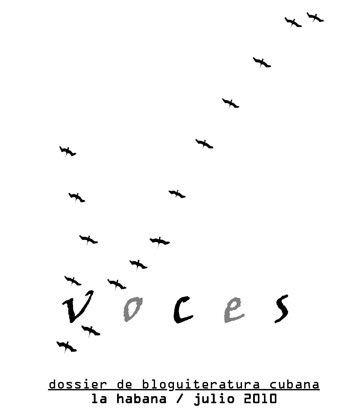
SOON VOCES, originally uploaded by orlandoluispardolazo.
Don’t you miss this Cubanesque editorial epiphaNY…!!!
